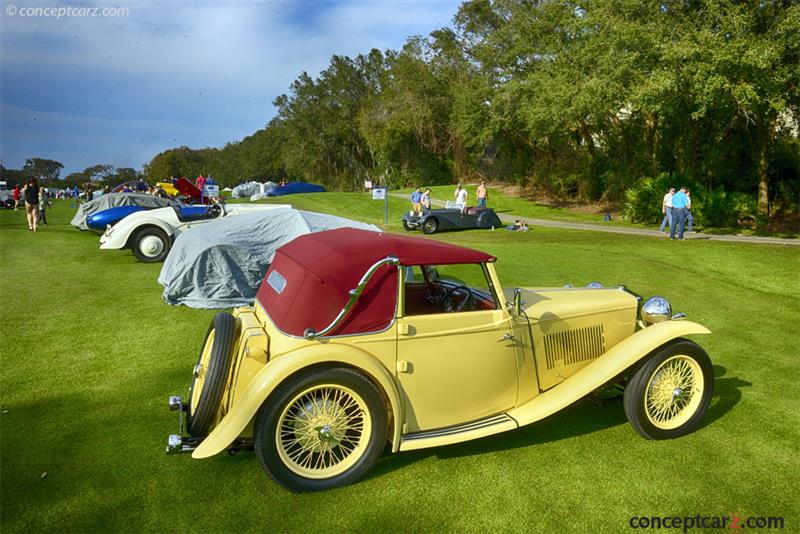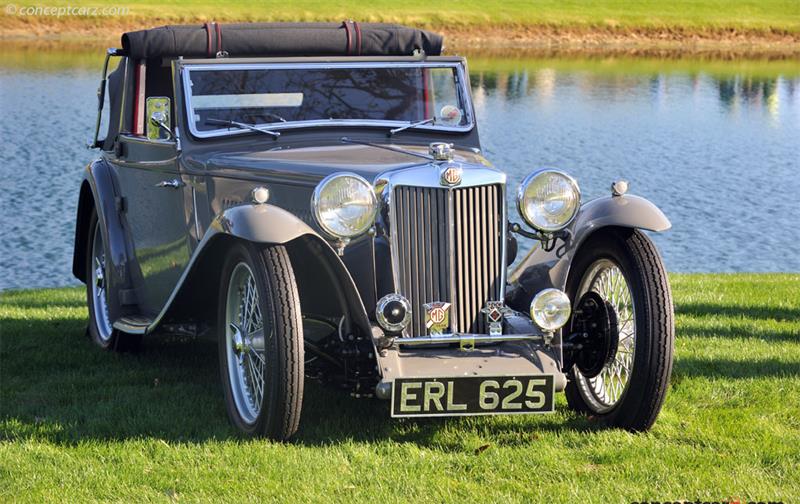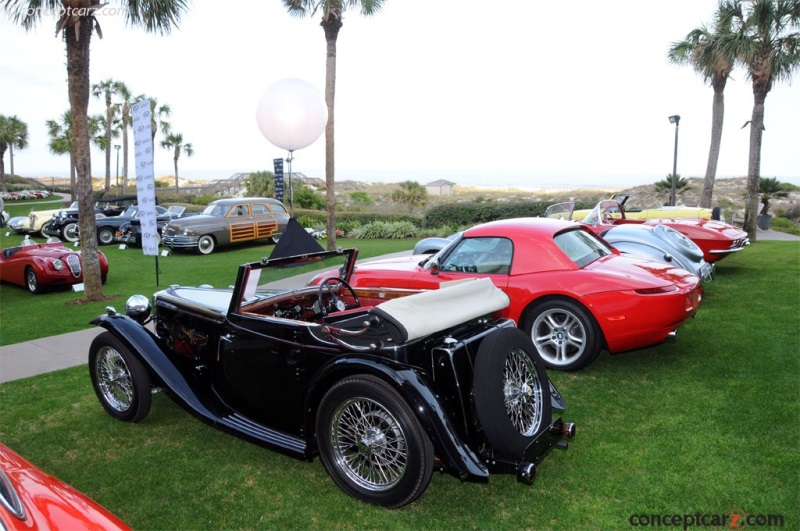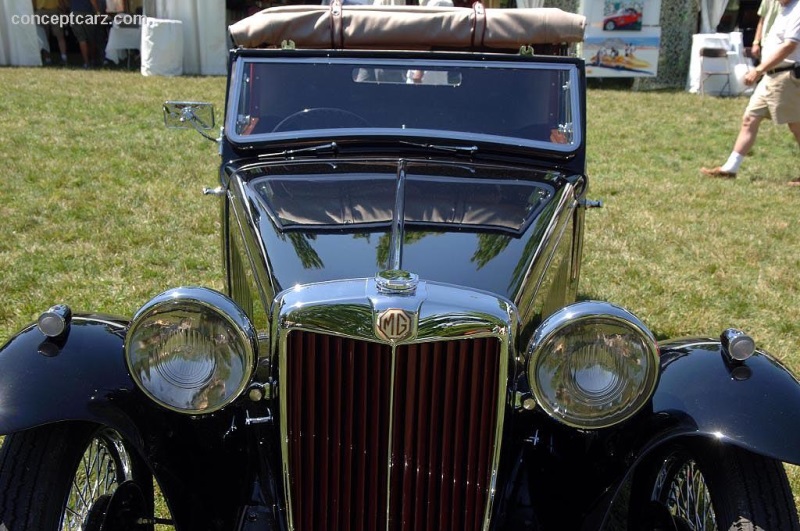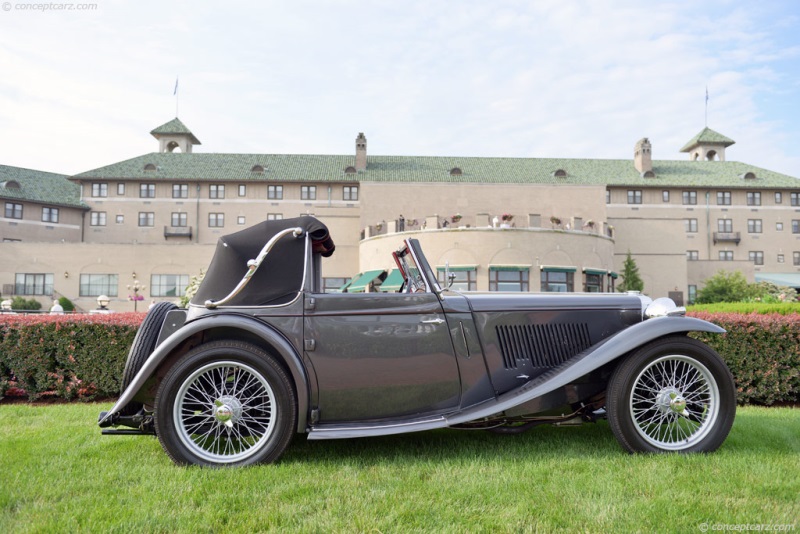History
The MG TA Midget appeared in the spring of 1936 as a replacement for the MG PB. It featured many components borrowed from Morris. Channel sections replaced the tubular cross-members making the vehicles ride more comfortable. The suspension was provided by leaf springs and beam-axle in the front and rear. The brakes were hydraulically operated drums, a first for MG. The body shell was assembled around the MG traditional way of using a wooden frame. All this added up to a total weight of 1,765 pounds.
A 1292 cc, overhead-valve, pushrod, four-cylinder engine was placed in the front and powered the rear wheels. Outfitted with dual horizontal SU carburetors, the engine produced 50 horsepower. The four-speed manual gearbox was synchromesh, another first for MG.
When first introduced, the two-seater vehicle could be purchased in an open and closed configuration. Later, the open coupe, referred to as an Airline Coupe, was replaced with a Drophead style. The Drophead used a soft-top that could open and close depending on the driver and the weather conditions.
In 1939 World War II was beginning. MG was introducing its latest vehicle, the TB Midget. It was basically the same as the TA but was equipped with a larger, 1250cc, engine. The four-cylinder over-head valve, XPAG power plant was borrowed from the new Morris 10. It produced 45 horsepower and was much more reliable than its predecessor. When the war began, production ceased. MG shifted its focus to creating equipment for military purposes.
At the end of the War, MG introduced the TC Midget. This was essentially a TB with very few modifications. The chassis was modified with rubber bush shackles in place of the sliding trunnion spring mountings. The transmission was the single-plate dry clutch and four-speed synchromesh unit. The engine was the XPAG 1250 cc pushrod engine. It was essential a TB offered in one body style, an open two-seater.
Even though the TC was a rebirth of an old model and used outdated mechanical equipment but with a modern interior, the TC Midget was very successful. During its four-year production run, lasting from 1945 through 1949, more than 10,000 TC's were created.
In 1949, the TC was replaced by the TD Midget. It visually appeared like the previous Midgets but was very different in mechanical ways. With a new chassis, it was sturdier and provided a comfortable ride. An independent suspension with double wishbones and coil springs were placed in the front. The vehicle was left-hand drive. The engine and transmission were identical to the TC. To comply with newly developed safety concerns and regulations, bumpers were placed on the front and in the rear.
A Mark II version used a more powerful version of the XPAG engine. With larger carburetors and higher compression ratio, the vehicle produced 57 horsepower. The suspension was modified and the interior received bucket seats.
During its four-year production run, the TD experienced even more success than its predecessor. Just like the TC, many of the TD Midgets were exported to the United States.
In 1953, the TD was updated and dubbed the TF. It was given a 1466 cc engine. Production continued through 1955 when it was replaced by the MGA.
Prior to World War I, the future of the company was unknown. Thanks to the success of the TA, the road was paved for MG to continue its prosperous status after the War. The models that followed brought modifications both visually and mechanically. The T-Series, lasting from 1936 through 1955, was a simple and reliable two-seater sports car that was fun to drive.
By Daniel Vaughan | Mar 2006
A 1292 cc, overhead-valve, pushrod, four-cylinder engine was placed in the front and powered the rear wheels. Outfitted with dual horizontal SU carburetors, the engine produced 50 horsepower. The four-speed manual gearbox was synchromesh, another first for MG.
When first introduced, the two-seater vehicle could be purchased in an open and closed configuration. Later, the open coupe, referred to as an Airline Coupe, was replaced with a Drophead style. The Drophead used a soft-top that could open and close depending on the driver and the weather conditions.
In 1939 World War II was beginning. MG was introducing its latest vehicle, the TB Midget. It was basically the same as the TA but was equipped with a larger, 1250cc, engine. The four-cylinder over-head valve, XPAG power plant was borrowed from the new Morris 10. It produced 45 horsepower and was much more reliable than its predecessor. When the war began, production ceased. MG shifted its focus to creating equipment for military purposes.
At the end of the War, MG introduced the TC Midget. This was essentially a TB with very few modifications. The chassis was modified with rubber bush shackles in place of the sliding trunnion spring mountings. The transmission was the single-plate dry clutch and four-speed synchromesh unit. The engine was the XPAG 1250 cc pushrod engine. It was essential a TB offered in one body style, an open two-seater.
Even though the TC was a rebirth of an old model and used outdated mechanical equipment but with a modern interior, the TC Midget was very successful. During its four-year production run, lasting from 1945 through 1949, more than 10,000 TC's were created.
In 1949, the TC was replaced by the TD Midget. It visually appeared like the previous Midgets but was very different in mechanical ways. With a new chassis, it was sturdier and provided a comfortable ride. An independent suspension with double wishbones and coil springs were placed in the front. The vehicle was left-hand drive. The engine and transmission were identical to the TC. To comply with newly developed safety concerns and regulations, bumpers were placed on the front and in the rear.
A Mark II version used a more powerful version of the XPAG engine. With larger carburetors and higher compression ratio, the vehicle produced 57 horsepower. The suspension was modified and the interior received bucket seats.
During its four-year production run, the TD experienced even more success than its predecessor. Just like the TC, many of the TD Midgets were exported to the United States.
In 1953, the TD was updated and dubbed the TF. It was given a 1466 cc engine. Production continued through 1955 when it was replaced by the MGA.
Prior to World War I, the future of the company was unknown. Thanks to the success of the TA, the road was paved for MG to continue its prosperous status after the War. The models that followed brought modifications both visually and mechanically. The T-Series, lasting from 1936 through 1955, was a simple and reliable two-seater sports car that was fun to drive.
By Daniel Vaughan | Mar 2006
Similarly Sized Vehicles
from 1938
1938 MG TA Vehicle Profiles
Recent Vehicle Additions
Performance and Specification Comparison
TA Specification Comparison by Year
Year
Production
Wheelbase
Engine
Prices
Related Automotive News

Famous & Rare Prewar MGs Star At 'The Amelia' 2018
MG will be honored at the 23rd annual Amelia Island Concours dElegance on March 11, 2018.
The sports cars from Morris Garages were founding members of postwar American sports car racing. The 23rd annual Amelia will celebrate marque-founder Cecil...

Amelia Island Concours dElegance Announces Special Classes For 2018
The 23rd annual Amelia Island Concours dElegance will host eleven special classes in 2018.
HUNTING CARS - Among the rarest of the custom coachwork cars none are more specialized, exotic and hardworking than the cars created especially...

1965 Mexico Grand Prix: Ginther Finally Gets It!
Richie Ginther had come so close so many times in the past but had always been outshone by someone else for victory. Now with the new Honda Team, it seemed anybody other than Ginther would win. But all of that would change on the 24th of October, 1965.
Ginthers...

BMW TEAM RLL FINISH 3RD AND 4TH AT PETIT LE MANS
BMW Team RLL finished its fourth season of American Le Mans Series competition with third and fourth place GT class finishes at the 15th annual 1000-mile Petit Le Mans. The teams seventh podium finish of the year, that included victories at Sebring...

BMW Team RLL Wins Road America For The Third Time In Four Years
For the third time in four seasons of American Le Mans Series competition, BMW Team RLL drove a BMW M3 GT across the Road America finish line first to win the four-hour Road America Road Race Showcase.
Today it was Bill Auberlen and Jörg Müller who...























